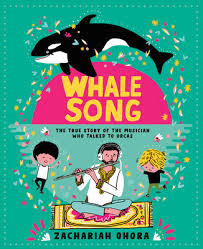Whalesong: The True Story of the Musician Who Talked to Orcas

Whalesong: The True Story of the Musician Who Talked to Orcas
Dr. Spong held a small herring near Haida’s mouth and rubbed his nose.
“Please eat,” Dr. Spong whispered.
Haida opened his month a bit. Then a little bit more.
Finally, he opened his mouth wide and accepted a tasty herring. Haida had eaten something! Hooray!
All the while, Paul played the happiest, most beautiful notes. Gorgeous melodies filled the air.
Zachariah OHora is both the author and illustrator of this captivating and informative true story about “two whales, two boys and two Pauls.”
The two whales are Haida and Chimo who resided at Sealand of the Pacific aquarium when musician Paul Horn moved to Vancouver Island with his two sons in 1971. At that time, scientist Dr. Paul Spong was researching whether it was possible to use music to communicate with killer whales, also known as orcas.
Paul Horn’s sons, Marlen and Robin, persuade him to play his flute for the orcas, and a bond is created.
The story takes a dark turn when one of the orcas dies and the other orca seems depressed and stops eating. Fortunately, Paul Horn’s flute music reignites the connection between the humans and the whale, and Chimo begins eating again.
But the story doesn’t end there.
Dr. Spong’s research on orcas, along with Paul Horn and his songs, helped people see how much orcas suffer in captivity.
The Pauls knew their next mission was to free all orcas in captivity and to continue to study them in the wild … where they belong.
A double page of additional information at the back of Whalesong: The True Story of the Musician Who Talked to Orcas includes facts about Paul Horn, orcas, and Dr. Spong and OrcaLab.
He [Dr. Spong] helped start the Save the Whales movement with Greenpeace, and his research and efforts have had a huge and positive effect in reducing commercial whaling.
OrcaLab is still working to free all whales in captivity.
A link to OrcaLab.org, which will take you to several live cams showing orcas and other sea mammals in the wild, is the perfect follow up to this story.
I highly recommend Whalesong: The True Story of the Musician Who Talked to Orcas. In addition to being an excellent introduction to a successful wildlife conservation story, it is also a story of the power of music to heal and connect. Young readers will enjoy the simple but evocative illustrations that support a story of caring for and respecting our fellow creatures. You can add an additional layer of enjoyment by playing some Paul Horn music as you introduce this story. And then go to the live cam OrcaLab links. It’s hard to imagine this book won’t make an impression of everyone who reads and hears the story.
Suzanne Pierson is a retired teacher librarian and library course instructor who tends her Little Free Library in Prince Edward County, Ontario, for the enjoyment of her friends and neighbours of all ages.
